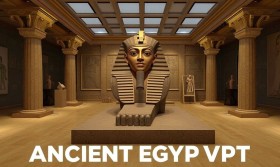Have you ever stood before the weathered stones of the Roman Forum and tried, really tried, to imagine the thunder of chariot wheels on the Via Sacra, the scent of incense from a nearby temple, the heated debates of senators that echoed through the air? It’s a challenge, isn't it? We see the skeletons of history, but the flesh, the spirit, the sheer overwhelming life of it all often feels just out of reach. That is, until now. Welcome to the latest expansion for the groundbreaking History Museum Simulator VR: the Roman Empire DLC. This isn't just an update; it's a time machine.
This expansion completely redefines what it means to experience a virtual reality history lesson. Forget static displays and dry placards. Here, you are no longer a passive observer. You are an active participant in a living, breathing world. The core experience of the base game—the ability to pick up, examine, and interact with priceless artifacts—is now supercharged with the grandeur and complexity of one of history's most fascinating civilizations. The Roman Empire DLC is designed not just to show you history, but to let you feel its weight in your hands and its echoes in your ears.
So, how do you begin your journey? The process is seamless. Once the DLC is installed, you'll boot up your VR headset and find a new, grand archway has appeared in the main museum hall, flanked by stone eagles and laurel wreaths. Stepping through this portal is a moment of pure magic. The sterile, climate-controlled air of the modern museum gives way to the warm, dusty breeze of the Mediterranean, carrying the distant sounds of a bustling city. Your transformation from museum visitor to time-traveling explorer is instantaneous.

Upon entering, you're greeted by a new digital curator, a holographic figure named Marcus Fabius, a veteran legionary turned scholar. His friendly, authoritative voice will be your guide. He explains that this simulation is structured around several key "Experiences," each focusing on a different facet of Roman life. You are free to choose your own path, creating a truly personalized historical exploration. This is the heart of immersive educational technology—learning by doing, by seeing, by being there.
Your first stop might be the heart of the empire: the Roman Forum. The scale is breathtaking. You look up at the towering marble columns of the Basilica Julia, their white stone gleaming in the sun. Senators in pristine white togas, bordered with purple, stride purposefully past you, their conversations a low murmur of Latin. You can reach out and run your fingers over the cool, intricately carved surface of a triumphal arch, feeling every chisel mark. This is more than a reconstruction; it's a dynamic historical simulation. The time of day changes, and with it, the atmosphere. Visit at dawn to see merchants setting up their stalls, or at noon to feel the energy of the crowded streets.
But the true magic of this DLC lies in its interactive exhibits. Marcus Fabius will guide you to a pedestal holding a standard legionary's helmet, a gladius (sword), and a segment of lorica segmentata (plate armor). This is where the virtual reality history lesson becomes tangible. You can pick up the helmet, noting its surprising weight and the clever cheek guards designed to protect the face without obstructing vision. You can strap on the armor, feeling how the metal plates articulate with your movement. Then, you can grip the hilt of the gladius. This isn't just a model; the haptic feedback in your VR controllers simulates the weapon's balance and heft. Marcus explains the philosophy behind the design—the gladius was not for slashing, but for brutal, efficient thrusting in tight formation. This level of artifact interaction in VR transforms abstract knowledge into visceral understanding.
Perhaps politics and power are more your interest. Marcus will direct you to the Curia, the Senate House. Here, you don't just watch a debate; you are in the room. You can take a seat on the wooden benches and listen as Cicero himself delivers a powerful oration against Catiline. The speech is in Latin, but real-time subtitles appear, and the emotion in his voice is universal. You feel the tension in the room, the divided loyalties, the weight of the republic's future hanging in the balance. This is a prime example of experiential learning in virtual reality. You're not reading about the fall of the Republic; you are witnessing the political passions that fueled it.
For a truly unique perspective, the DLC offers a "God Mode." With a voice command or a menu selection, you can ascend above the city, watching the ant-like bustle of the Forum from a hundred feet in the air. You can then zoom out further, seeing the entire city of Rome laid out like a magnificent map, with the Tiber River snaking through it. From here, you can select different time periods. Watch the Great Fire of Rome spread through the narrow streets in 64 AD, and then, with a slider, fast-forward through time to see the construction of the massive Flavian Amphitheater—the Colosseum—rising from the ashes of Nero's palace. This macro-to-micro view is an unparalleled tool for understanding urban development and historical causality.

No trip to ancient Rome would be complete without the games. The Colosseum experience is arguably the DLC's most spectacular set piece. You can enter the vast arena, standing on the sand-covered wooden floor and looking up at the roaring crowd of 50,000 spectators. The scale is humbling and slightly terrifying. You can explore the hypogeum—the labyrinthine underground—where gladiators, slaves, and wild animals waited for their fate. An interactive exhibit here allows you to hold the different types of gladiator weapons and armor: the net and trident of a Retiarius, or the heavy shield and helmet of a Murmillo. Marcus Fabius provides crucial context, explaining the social, political, and brutal realities of the games, moving beyond spectacle to a deeper, more nuanced understanding. This is interactive cultural heritage at its most powerful and thought-provoking.
Beyond the city's limits, the DLC offers two more profound experiences. First, you can step onto the deck of a Roman merchant ship as it crosses the Mediterranean. Feel the virtual wind, see the sails billow, and watch the sailors work. Then, you can visit the very edge of the empire, standing on Hadrian's Wall in the damp chill of Britannia. Look north into the misty, untamed lands of the Picts, and then south to the ordered, "Roman" world behind you. The contrast is stark and speaks volumes about the concepts of civilization, frontier, and empire. These moments of quiet reflection are as educationally valuable as the grand spectacles.
The Roman Empire DLC for History Museum Simulator VR represents a paradigm shift. It answers the question of why we should care about ancient history by making it immediate, sensory, and emotionally resonant. It’s a tool for students to go beyond their textbooks, for history enthusiasts to satisfy their deepest curiosity, and for anyone with a sense of wonder to walk where legends were born. This is not the end of the journey. One can easily imagine future DLCs exploring the pyramids of Giza, the Great Wall of China, or the markets of medieval Venice. For now, the legions await, the Senate is in session, and an entire empire is waiting for you to explore. All you have to do is take that first step through the arch.



















